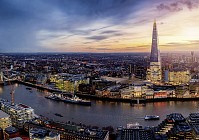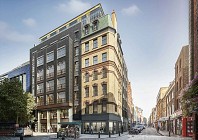London’s fine-dining scene during the 1980s was rather different to today. Back then, a well-regarded restaurant could survive by serving a three-course menu of a prawn cocktail (cold shrimps drowned in ketchup and mayo), a kidney-filled pie, and a worryingly wobbly dessert. Those with the airs and graces to order wine may be offered simply “red or white”. And if you had asked an Italian, an American or a French person about the city’s culinary credentials, they’d be reaching for the joke books.
Yet, less than 30 years on, the story could not be more different. In 2014 London is considered to be one of the culinary capitals of the world. So, how has the British capital managed to pull off this great transformation over the course of a single generation? It boils down to a few key elements, from diversity to creativity.
Changing attitudes
The first and perhaps most significant impact on London’s culinary scene in the last 30 years has been the changing attitudes of the population. Since the recession of the early ’80s, incomes in the UK have steadily increased, leading to a burgeoning middle class — especially in London — who began to travel overseas. Exposure to more refined cuisine and smarter service meant they returned home with greater knowledge, more distinguished palates and heightened expectations, which led to more fine-dining restaurants opening in the city, eager to service a new breed of Londoner who valued quality over cost.

Michelin-starred Marcus Wareing, chef patron of Marcus at The Berkeley, believes Britain has been through a huge cultural shift when it comes to food. “Our attitudes to food have changed immensely over the last 30 years,” he says. “Food has become more and more central to our daily lives. We’ve very much followed the European approach to food, where the kitchen is the heart of the home and meal times are central to life, bringing families and friends together to enjoy great food and wine.
“We are also now far more aware of what we’re eating, the nutritional value, and the origin of produce than we were 30 years ago,” he adds. The growth in organic and fair-trade restaurants has been huge, but there’s also an increasing amount of restaurants catering to specialist diets, from vegetarian and vegan to gluten-free.
Leading chef Alyn Williams believes this shift in attitudes is the biggest contributor to the capital’s new status as a culinary heavyweight. “The change in British attitudes to food is immeasurable,” he claims. “As diners we’ve become much more open minded. The dining culture has transformed from the bottom to top-end; to every cooking level and price range you can imagine. I think the pub-dining scene — this casual, yet sophisticated, way of dining — has revolutionised the way we look at eating out. We are now punching our weight alongside Paris, Barcelona and Milan, and that wasn’t always the case.”
Star power
Bit by bit, Britain has evolved from a country of culinary philistines to a nation of real foodies. Dining out, once considered the wasteful extravagance of city bankers, became a regular expectation for people of almost all backgrounds and incomes. Cookery programmes began to dominate television schedules and celebrity chefs like Marco Pierre White brought rock-and-roll glamour to the stuffy world of haute cuisine. Today’s star chefs, like Jamie Oliver, Gordon Ramsay and Nigella Lawson, oversee multi-million-dollar empires.
“The rise of the ‘celebrity chef’ has changed the culinary landscape in a very positive way,” explains Wareing. “People gravitate to them and listen and learn from them. Look at what Jamie Oliver has done. Not only has he opened up a new breed of restaurants to London, offering delicious but very affordable food, he has also connected in a real way to the average person regarding standards of home cooking.”
It’s also worth noting that London’s food revolution has been led by a re-emergence of quality British cuisine. The 2014 World’s 50 Best Restaurants list has London restaurant Dinner by Heston Blumenthal, renowned for serving traditional and historical British dishes, at number five, while fellow London diner The Ledbury also features in the top 10. “Chefs like Tom Kerridge and Nathan Outlaw use brilliant British produce and old-fashioned recipes and make them new, relevant and interesting,” says Atul Kochhar, chef patron at Benares in Mayfair. “This has really changed the way people within the UK think about British food.”

Cultural riches
London in the 21st century is the very definition of a cultural melting pot. Today, London’s population is approximately 8.5 million people, of which more than a third were born outside of the country, with many more considering themselves of non-British descent. As such, London boasts a UN of dining options.
“We have always been a culturally-rich capital, and have a long history of immigration which has always been reflected in our restaurants,” says Williams. “When I was growing up, we had a lot of Indian, Jewish and classic European places to eat.” But he believes that the diversity in dining in London has increased rapidly since then. “Since the 1980s we have seen a sharp rise in Eastern European and African restaurants. I think the unique character in London’s dining scene is down to its diversity, as we have almost every nationality on earth represented within the city. I reckon you will find over 100 different cuisines by country here, and I doubt there are many other cities that can boast that.”
In reality, that’s probably a conservative estimate. At the top end of the dining scene alone, things are extraordinarily diverse. London has Michelin-starred restaurants serving British, Indian, Italian, French, Chinese, Spanish, Portuguese, Japanese and Peruvian food, while hundreds of other international diners have landed top culinary awards.
“London is the most diverse city in the world,” claims Michel Roux Jr, the dynamic two-Michelin-starred chef at Le Gavroche. “It is a vibrant melting pot of top-class cuisine, with chefs coming from just about everywhere to set up here.” Kochhar agrees: “Probably because of the Empire and due to the UK’s approach to travel, we have the most vibrant food scene in the world. There’s no other country that can match the breadth and variety we can offer here; this is the most exciting place in the world to eat out.”
Kitchen creativity
Ironically for a city of such creativity (the birthplace of John Keats, Alfred Hitchcock and David Beckham) British food traditionally lacked imagination. Yet, in the last 30 years, things have changed, and London has been at the forefront of a number of global culinary developments, including trends such as ‘molecular gastronomy’ (a scientific approach that looks at the physical and chemical transformations of food elements during cooking), restaurant trends like ‘multi-sensory dining’ (a radical culinary concept proposed by Heston Blumenthal, in which dishes are complemented by songs or works of art), and kitchen trends such as chef collaborations and exchanges.
These new concepts allow diners to experience more styles and chefs to try out new ways of presenting ingredients. “They are a great way to eat food by chefs you would otherwise find difficult to visit” says Williams. Wareing adds: “The best thing about London is there are always exciting new pop-ups, street vendors, restaurants, cafés, markets, delis and food stores springing up all across the city. This is what gives London its unique buzz.”
When it comes to fine dining, Kochhar believes there are a handful of restaurants that have left a particularly unique impression in recent years. “St. John (and the nose-to-tail eating concept) had a huge impact on people’s approach to offal and making the most of every animal; The River Café taught us that there’s an art to special dining that retains its casual feel; and I think that SushiSamba has reminded us that Londoners like a bit of glitz and glamour, too. They’ve all had a positive impact on how we eat out.”
This newfound readiness to adapt and experiment has certainly contributed to London’s rise from culinary whipping boy to gastronomic guru. While other major foodie cities with strong and respected culinary traditions have proved reluctant to mess with tried-and-tested formulas, London’s less-stellar reputation has given chefs the confidence to constantly experiment, reinvent and reinvigorate. “British chefs like to be more experimental, and are influenced by international cuisines,” explains Roux Jr. “They are less worried about maintaining traditional approaches to creating dishes. This sets London’s restaurant scene apart.”
With such an incredibly diverse range of dining options available — from traditional British cuisine to inventive international fare — and a multi-cultural population with an endless appetite for dining out, it’s no wonder London can now compete with the likes of Paris, Rome and Tokyo as the fine-dining capital of the world. And Williams believes we’re only seeing the beginning. “With every generation, lots of talented cooks are emerging. I look forward to seeing what the next 20 years bring.”

















